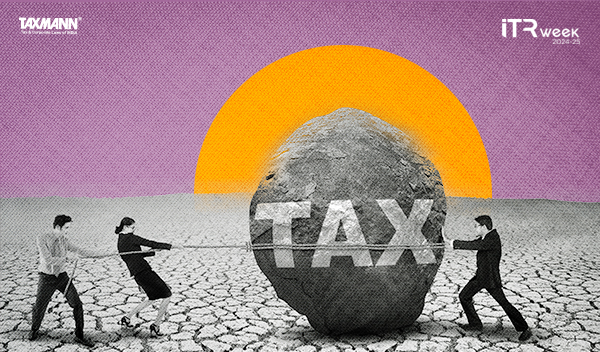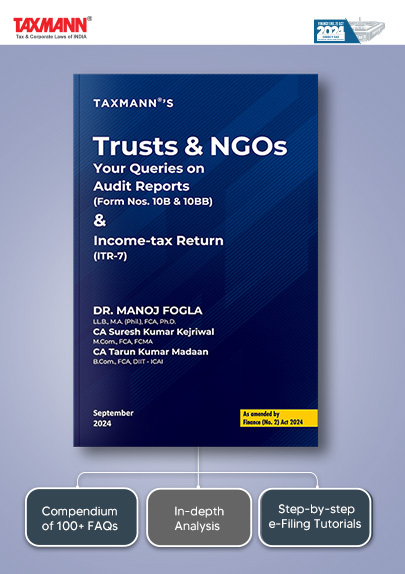Income Tax Returns (ITR) | New Tax Regime vs. Old Tax Regime
- ITR Week 2024-25|Blog|Income Tax|
- 6 Min Read
- By Taxmann
- |
- Last Updated on 14 June, 2024
The choice between the new and old tax regimes depends on your eligible deductions and exemptions. New Tax Regime – Beneficial if you have minimal deductions. Features lower tax rates but disallows most exemptions and deductions. Old Tax Regime – Favourable if you claim significant deductions like Section 80C, 80D, and home loan interest under Section 24.
FAQ 1. What is the New Tax Regime under Section 115BAC?
Section 115BAC of the Income Tax Act introduces an alternative tax regime for Individuals, Hindu Undivided Families (HUFs), Associations of Persons (AOPs), Bodies of Individuals (BOIs), and Artificial Juridical Persons (AJPs), collectively referred to as ‘eligible assesses.’ Under this regime, eligible assesses can opt to be taxed at reduced rates based on their income brackets.
The tax rates under the new regime are as follows:
|
Total Income (Rs) |
Tax Rate |
| Up to 3,00,000 |
Nil |
| From 3,00,001 to 6,00,000 |
5% |
| From 6,00,001 to 9,00,000 |
10% |
| From 9,00,001 to 12,00,000 |
15% |
| From 12,00,001 to 15,00,000 |
20% |
| Above 15,00,000 |
30% |
To qualify for the new tax regime, an assessee must adhere to the following conditions:
- The total income must be computed without claiming specified exemptions and deductions
- The total income must be computed without setting off losses or depreciation carried forward from previous years if these are attributable to specified exemptions and deductions
- The total income must be computed without setting off any loss under the head “Income from house property” against any other head of income
- The total income must be calculated after claiming depreciation in the prescribed manner. If the depreciation rate for any block of assets exceeds 40%, it is restricted to 40%
- The total income must be computed without claiming any exemptions or deductions for allowances or perquisites provided under any other law currently in force
| Read More New Tax Regime for Individuals, HUFs, AOPs, BOIs or AJPs on Taxmann.com/Practice |
FAQ 2. How to Choose Between the Old and New Tax Regime?
Choosing between the old and new tax regimes depends on the amount of exemptions and deductions available to the assessee. If an individual has no deductions or exemptions to claim, it is generally beneficial to opt for the new tax regime. However, if an individual can claim deductions or exemptions such as those under Section 80C, Section 80D, House Rent Allowance, or interest on a housing loan under Section 24, it is advisable to calculate taxes under both regimes to determine which option is more advantageous.
| To calculate the tax under both regimes, you may use ‘Tax Calculator – Old Regime Vis-À-Vis New Regime’ available on the Income-tax Dept. website. |
FAQ 3. What Are the Exemptions and Deductions Not Available in the New Tax Regime?
Opting for the lower tax rates under the new tax regime requires computing the total income without claiming the following exemptions and deductions:
- Leave Travel Concession [Section 10(5)]
- House Rent Allowance [Section 10(13A)]
- Official and Personal Allowances (other than those prescribed) [Section 10(14)]
- Allowances to MPs/MLAs [Section 10(17)]
- Exemption for Income of Minor [Section 10(32)]
- Deduction for Units in Special Economic Zones (SEZ) [Section 10AA]
- Entertainment Allowance [Section 16(ii)]
- Professional Tax [Section 16(iii)]
- Interest on Housing Loan (for self-occupied house property) [Section 24(b)]
- Additional Depreciation for New Plant and Machinery [Section 32(1)(iia)]
- Deduction for Investment in New Plant and Machinery in Notified Backward Areas [Section 32AD]
- Deduction for Tea, Coffee, or Rubber Business [Section 33AB]
- Deduction for Prospecting, Extraction, or Production of Petroleum or Natural Gas in India [Section 33ABA]
- Deduction for Donations to Approved Scientific Research Associations, Universities, Colleges, or Institutes [Section 35(1)(ii)]
- Deduction for Payments to Indian Companies for Scientific Research [Section 35(1)(iia)]
- Deduction for Donations to Universities, Colleges, or Institutions for Social Science or Statistical Research [Section 35(1)(iii)]
- Deduction for Donations for Scientific Research or Expenditure on Scientific Research [Section 35(2AA)]
- Deduction for Capital Expenditure on Specified Businesses (e.g., cold chain facility, warehousing facility) [Section 35AD]
- Deduction for Expenditure on Agriculture Extension Projects [Section 35CCC]
- Deductions under Sections 80C to 80U pexcept those under Section 80JJAA, Section 80CCD(2), Section 80CCH(2), and Section 80LA(1A)) [Chapter VI-A]
| Read More New Tax Regime for Individuals, HUFs, AOPs, BOIs or AJPs on Taxmann.com/Practice |
FAQ 4. What are the Break-Even Points for Deductions at Different Income Levels?
The following table shows the break-even points for deductions at various income levels, indicating where the tax liability is the same under both the old and new tax regimes.
|
Income (Rs) |
Deductions Required for Break Even (Rs) | Tax Liability under New Regime (Rs) | Tax Liability under Old Regime (Rs) |
Comments |
|
8,00,000 |
1,87,500 | 36,400 |
36,400 |
The new regime is beneficial if the assessee claims deductions less than Rs. 1,87,500 |
|
9,00,000 |
2,37,500 | 46,800 | 46,800 |
The new regime is beneficial if the assessee claims deductions less than Rs. 2,37,500 |
| 10,00,000 | 2,62,500 | 62,400 | 62,400 |
The new regime is beneficial if the assessee claims deductions less than Rs. 2,62,500 |
|
12,50,000 |
3,12,500 | 1,04,000 | 1,04,000 |
The new regime is beneficial if the assessee claims deductions less than Rs. 3,12,500 |
| 15,00,000 | 3,75,000 | 1,56,000 | 1,56,000 |
The new regime is beneficial if the assessee claims deductions less than Rs. 3,75,000 |
FAQ 5. Which Tax Regime Should I Choose if I Earn a Salary of Rs. 14 Lakhs?
For the financial year 2023-24, if you have a salary of Rs. 14 lakhs and paid Rs. 4 lakhs to repay the principal of a home loan, Rs. 50,000 for health insurance, and Rs. 1.5 lakh towards the interest on the home loan; the following comparison will help determine the best tax regime for you.
Here’s a comparison in a table format for an individual under 60 years of age:
|
Particulars |
Old Tax Regime (Rs.) |
New Tax Regime (Rs.) |
| Salary Income [A] |
14,00,000 |
14,00,000 |
| Eligible Deductions | ||
| • Standard Deduction |
50,000 |
50,000 |
| • Section 80C (Repayment of Home Loan) |
1,50,000 |
– |
| • Section 80D (Health Insurance Premium) |
50,000 |
– |
| • Section 24(b) (Interest on Home Loan for Self-Occupied House) |
1,50,000 |
– |
| Total Deductions [B] |
4,00,000 |
50,000 |
| Net Taxable Income after Deductions [C = A – B] |
10,00,000 |
13,50,000 |
| Tax Payable [D] |
1,12,500 |
1,20,000 |
| Add: Health and Education Cess (4%) [E = D * 4%] |
4,500 |
4,800 |
| Total Tax Liability [F = D + E] |
1,17,000 |
1,24,800 |
In this example, the old tax regime results in a lower tax liability (Rs. 1,17,000) compared to the new tax regime (Rs. 1,24,800). Therefore, you should opt for the old tax regime.
FAQ 6. How to Opt for the New Tax Regime under Section 115BAC?
Effective from the Assessment Year 2024-25, the new tax regime will be the default option for Individuals, Hindu Undivided Families (HUFs), Associations of Persons (AOPs), Bodies of Individuals (BOIs), and Artificial Juridical Persons (AJPs). If an assessee prefers the old tax regime, they must explicitly opt out of the new tax regime.
For those with income from a business or profession, opting out of the new tax regime and switching to the old tax regime requires furnishing Form No. 10-IEA on or before the due date for filing the income return under Section 139(1). Once this option is exercised, it applies to the year it is chosen and the subsequent assessment year.
Form No. 10-IEA can be filed online at Income Tax e-Filing Portal by navigating to: e-file > Income Tax forms > file Income Tax Forms.
For those with income other than from a business or profession, the choice of the tax regime can be indicated in the Income Tax Return (ITR) while filing the income return.
| Read More New Tax Regime for Individuals, HUFs, AOPs, BOIs or AJPs on Taxmann.com/Practice |
FAQ 7. What Lower Tax Regimes Are Available to Other Assessees under the Income Tax Act?
The Income Tax Act provides alternative tax regimes for various types of assessees, as outlined in the table below. These regimes are not default options, so taxpayers wishing to opt for an alternative tax regime must file a specified form on or before the due date for filing an income tax return (ITR).
|
Alternative Tax Regime |
Applicable to | Filing of Form |
| Section 115BA | Domestic Company |
Form 10-IB |
|
Section 115BAA |
Domestic Company | Form 10-IC |
| Section 115BAB | Domestic Company |
Form 10-ID |
|
Section 115BAD |
Co-operative Society | Form 10-IF |
| Section 115BAE | Co-operative Society |
Form 10-IFA |
These forms can be filed online at the Income Tax e-Filing Portal by navigating to: e-file > Income Tax forms > file Income Tax Forms.
Dive Deeper:
Income Tax Returns (ITR) | Which ITR Form is to be filed for AY 2024-25
[FAQs] Income Tax Returns (ITR) | Requirement to File ITR
[FAQs] Income Tax Returns (ITR) | Updated Returns
[FAQs] Income Tax Returns (ITR) | Reporting in Schedules in ITR
[FAQs] Income Tax Returns (ITR) | e-Filing of ITR
[FAQs] Income Tax Returns (ITR) | Annual Information Statement (AIS)
[FAQs] Income Tax Returns (ITR) | Capital Gains
[FAQs] Income Tax Return | Tax Payment | TDS | TCS | Refunds
[FAQs] Income Tax Returns (ITR) | Deductions & Rebates
[FAQs] Income Tax Returns (ITR) | Set-off of Losses
[FAQs] Income Tax Returns (ITR) | Clubbing of Income
Disclaimer: The content/information published on the website is only for general information of the user and shall not be construed as legal advice. While the Taxmann has exercised reasonable efforts to ensure the veracity of information/content published, Taxmann shall be under no liability in any manner whatsoever for incorrect information, if any.

Taxmann Publications has a dedicated in-house Research & Editorial Team. This team consists of a team of Chartered Accountants, Company Secretaries, and Lawyers. This team works under the guidance and supervision of editor-in-chief Mr Rakesh Bhargava.
The Research and Editorial Team is responsible for developing reliable and accurate content for the readers. The team follows the six-sigma approach to achieve the benchmark of zero error in its publications and research platforms. The team ensures that the following publication guidelines are thoroughly followed while developing the content:
- The statutory material is obtained only from the authorized and reliable sources
- All the latest developments in the judicial and legislative fields are covered
- Prepare the analytical write-ups on current, controversial, and important issues to help the readers to understand the concept and its implications
- Every content published by Taxmann is complete, accurate and lucid
- All evidence-based statements are supported with proper reference to Section, Circular No., Notification No. or citations
- The golden rules of grammar, style and consistency are thoroughly followed
- Font and size that’s easy to read and remain consistent across all imprint and digital publications are applied






 CA | CS | CMA
CA | CS | CMA



2 thoughts on “Income Tax Returns (ITR) | New Tax Regime vs. Old Tax Regime”